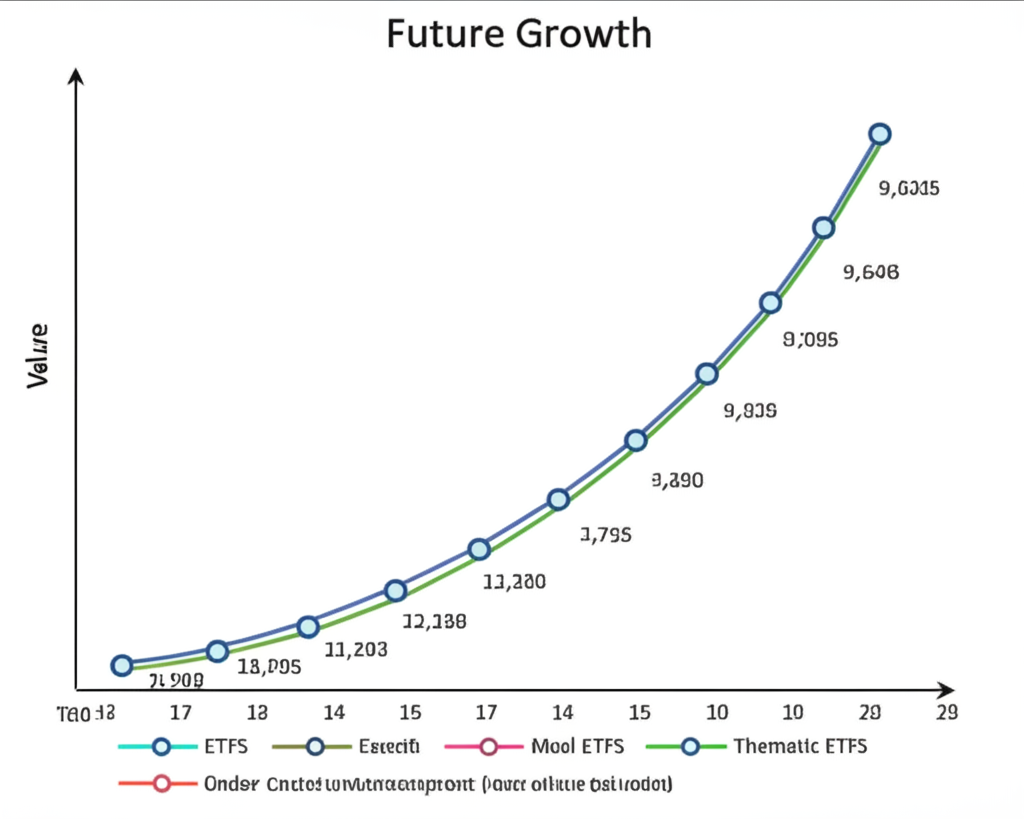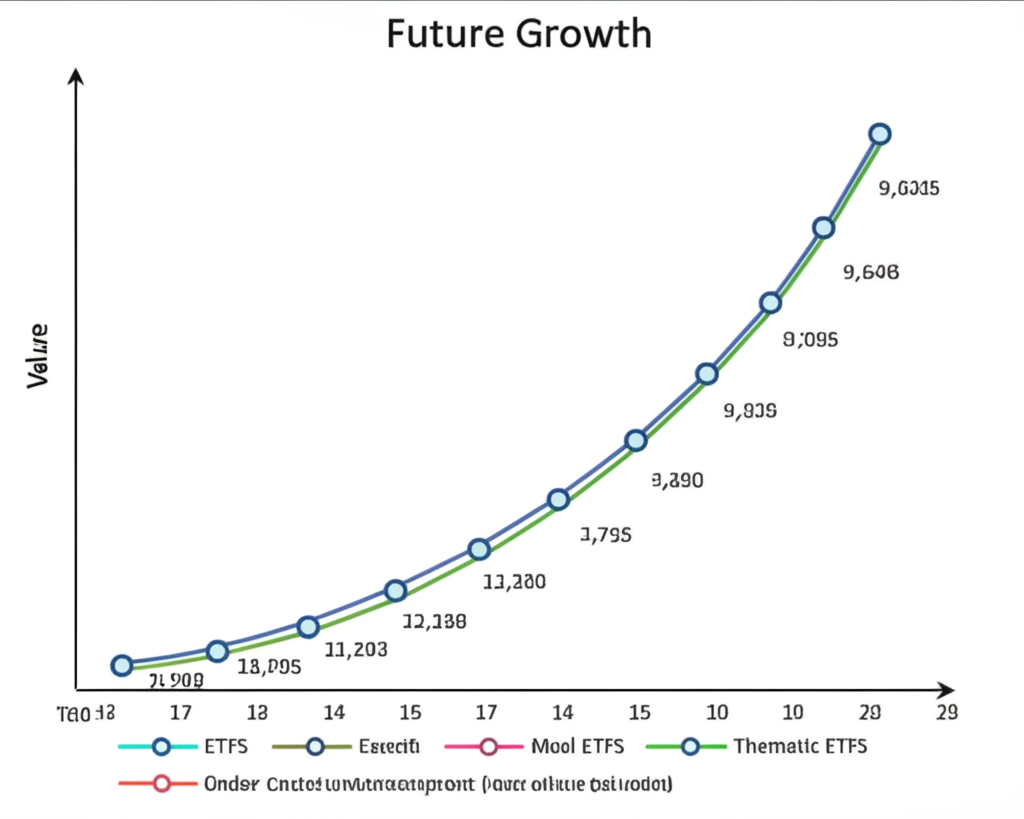The investment world keeps evolving, but 2025 stands out with breakthroughs in technology, major social changes, and urgent environmental needs that are redefining economies around the globe. For investors in the United States, thematic exchange-traded funds provide a smart way to tap into these enduring trends that could fuel substantial growth over time. Unlike standard funds tied to sectors or regions, these ETFs zero in on targeted themes or big-picture shifts poised to reshape markets.

This guide targets US investors at the beginner or intermediate level who want to dive into thematic investing. We’ll break down the basics of these ETFs, explain their inner workings, weigh the upsides against the downsides, and outline a clear plan for spotting, assessing, and adding them to your holdings heading into 2025. The goal here is to arm you with practical insights so you can spot opportunities and build toward lasting portfolio gains.

Understanding Thematic ETFs: A Deep Dive for US Investors
Rapid changes in technology and consumer habits are pushing the world forward faster than ever. Thematic investing lets you get ahead of these developments by aligning your assets with the forces set to drive real progress.
Defining Thematic Investing in the United States Context
Thematic ETFs gather capital from multiple investors to buy shares in companies expected to thrive from a key economic, tech, or social trend. They differ from conventional sector ETFs, which stick to broad industries such as tech or healthcare, by spanning multiple sectors and borders to highlight firms advancing a core story.
In the US, this approach means honing in on trends that will reshape the domestic economy and its key players. Take artificial intelligence (AI), for instance: rather than a catch-all tech fund, a thematic ETF might target AI specifically, pulling in firms from software, chips, and robotics that are building or using the technology. Themes with strong US ties include genomics, renewable energy, remote work evolution, and data protection-each pointing to deep, lasting changes. The key difference? Sector investments bet on what businesses do, while thematic ones focus on why they’re expanding, like how an older population spurs new medical advances.
How Thematic ETFs Work: Structure and Mechanics
These funds function similarly to most exchange-traded funds, building a spread-out mix of stocks or related assets tied to their focus area. The majority are passively run, mirroring a specialized index that tracks theme-related companies, though more active versions are emerging where managers pick holdings to beat the benchmark.
At their core, they involve:
- Underlying Assets: Mostly stocks from companies deeply engaged in the theme.
- Index Tracking vs. Active Management: Passive funds copy an index for steady replication, but active ones aim higher, which usually means steeper fees.
- Expense Ratios (ERs): The yearly cost as a slice of your stake-these run higher in thematic ETFs because of the specialized analysis required for their tight focus.
- Diversification within a Theme: Even with a narrow lens, solid thematic ETFs spread bets across dozens of companies to cut down on the danger of any one stock tanking the fund.
- Role of Rebalancing: Managers periodically tweak the lineup to stay true to the theme and respond to shifting conditions, like new regulations or tech leaps.
The Appeal of Thematic ETFs for United States Portfolios in 2025
US investors eyeing something fresh beyond everyday market plays will find thematic ETFs especially useful in a fast-moving year like 2025, where innovation takes center stage.
Tapping into Megatrends and Innovation
What draws people to thematic ETFs is their direct line to massive, ongoing shifts that are remaking economies and daily life, both worldwide and right here in the US. These aren’t quick hype cycles; they’re foundational changes with years of runway ahead. Standouts include:
- Digital Transformation: The steady pivot to online tools, cloud services, and digital shopping that’s infiltrating every corner of business.
- Sustainable Energy Transition: The push from oil and gas to renewables such as solar, wind, and hydrogen, boosted by US laws like the Inflation Reduction Act and company pledges for greener operations.
- Healthcare Innovation: Progress in biotech, gene editing, and virtual care, fueled by demographics like baby boomers entering retirement and cutting-edge research.
- Future of Mobility: The boom in electric cars, self-driving tech, and eco-friendly transport, with US firms leading the charge.
By getting in on these, US investors position themselves for the upside from trailblazing companies and game-changing ideas, adding a proactive edge to their overall strategy.
Potential for Enhanced Returns and Diversification
The big draw is the chance to outpace plain-vanilla market funds by zeroing in on explosive growth zones. No one can promise results based on history alone, but when a theme hits its stride, the payoffs can be impressive.
On top of that, these ETFs bring diversification perks to a well-rounded setup. Since they often move independently from mainstream sectors or indexes like the S&P 500, they can smooth out bumps and boost gains. A renewable energy fund, for example, might zig when the broader market zags, creating a fresh growth avenue without overlapping too much.
Navigating the Risks: What United States Investors Need to Know
The growth potential is exciting, but thematic ETFs come with hurdles that US investors can’t ignore if they want to decide wisely.
Concentration Risk and Volatility
Focusing so intently on one area amps up concentration risk-if the theme fizzles or stalls, the fund can take a real hit. This setup often means more ups and downs than a wide-ranging fund. To counter this, dig deep into a theme’s staying power before jumping in, steering clear of buzzworthy but fleeting ideas.
Valuation Challenges and Timing Risk
Hot themes draw crowds, which can inflate prices and set up for corrections when enthusiasm cools. You could end up entering at a high point, watching gains fade as realities like slower adoption kick in. Sectors like AI or biotech often ride waves of hype, so a patient, years-long view helps ride out the swings until the trend solidifies.
Liquidity and Expense Ratios
Niche thematic funds sometimes trade thinly, making it tougher to enter or exit positions smoothly during choppy times. Plus, those elevated expense ratios we mentioned earlier can chip away at profits; they’re worth it only if the fund’s approach delivers. The Securities and Exchange Commission (SEC) stresses that fees matter a lot for long-haul results. Source
How to Identify and Evaluate Thematic ETFs for Your US Portfolio in 2025
To weave these into your plan effectively, start with a solid framework: grasp the trend, scrutinize options carefully, and allocate thoughtfully.
Understanding the Thematic Narrative: Beyond the Hype
Don’t stop at flashy promotions-probe the real story behind the theme. For US folks, key questions include:
- Longevity and Impact: Does this have legs for decades, or is it a blip? How might it overhaul the US economy, jobs, or daily life?
- Drivers and Barriers: What’s propelling it forward, from tech jumps and government backing to shifting buyer preferences? And what could hold it back, such as policy roadblocks or rival innovations?
- Avoiding Fads: Separate solid megatrends with wide-reaching effects from trendy distractions. Digital overhaul, say, endures far beyond any single app or device.
A quick example: Social media virality might fade, but the overarching digital shift keeps gaining ground.
Due Diligence Checklist for US Investors
With a theme in mind, vet specific ETFs rigorously:
- Fund Provider Reputation: Check the sponsor’s history and know-how-think established names like Vanguard, Global X, iShares, or Ark Invest, backed by strong research teams.
- Underlying Index/Methodology: See how they pick and balance holdings. Is the process clear, sensible, and a true match for the theme? Passive or active?
- Holdings Analysis: Review the biggest positions-do they fit the theme you see? Is the spread broad enough, or overly reliant on a handful of names?
- Expense Ratios (ERs): Shop around for peers; slimmer fees keep more returns in your pocket.
- Historical Performance (with caveats): Use it as a window into resilience across cycles, benchmarked against fitting yardsticks, but never as a crystal ball.
- Assets Under Management (AUM): Bigger pools signal trust and easier trading; tiny ones risk shutting down.
Integrating Thematic ETFs into Your Existing US Investment Strategy
Treat thematic ETFs as satellites orbiting a stable core of broad funds, like an S&P 500 tracker or total US market ETF, for reliable exposure.
- Allocation Size: Keep it modest-say, 5-15% of your total-to match their riskier profile without dominating.
- Balancing Thematic Exposure: Spread across a few themes to avoid putting all eggs in one basket.
- Long-term vs. Short-term Views: This is marathon territory; tune out daily noise and hold through the long game.
- Review and Rebalance: Check in periodically to confirm alignment with your aims and market shifts, adjusting as life or trends change. For background, many advisors suggest annual reviews to keep things on track.
Top Thematic ETFs to Consider for United States Investors in 2025 (Examples)
Below, we spotlight key themes and sample ETFs relevant for US investors in 2025, to illustrate what’s out there. These are for illustration only, not buy recommendations-always do your homework.
| Theme | Key Trend & US Relevance | Example ETFs (Tickers) |
|---|---|---|
| Artificial Intelligence & Robotics | AI is transforming every sector in the US, from manufacturing to healthcare, driving efficiency and innovation. Robotics is automating labor. | Global X Robotics & Artificial Intelligence ETF (BOTZ), ROBO Global Robotics and Automation Index ETF (ROBO) |
| Clean Energy & Sustainability | US policy (e.g., Inflation Reduction Act) and corporate mandates are accelerating the transition to renewable energy sources and sustainable practices. | iShares Global Clean Energy ETF (ICLN), Invesco WilderHill Clean Energy ETF (QCLN) |
| Genomics & Biotechnology | Breakthroughs in gene sequencing, personalized medicine, and biotech innovation are revolutionizing healthcare in the US. | ARK Genomic Revolution ETF (ARKG), Global X Genomics & Biotechnology ETF (GNOM) |
| Cybersecurity & Digital Transformation | As digital transformation accelerates, the need for robust cybersecurity solutions grows exponentially for US businesses and individuals. | ETFMG Prime Cyber Security ETF (HACK), First Trust NASDAQ Cybersecurity ETF (CIBR) |
| Future of Finance (Fintech) | Financial technology is disrupting traditional banking and payment systems, driving efficiency and accessibility across the US financial sector. | Global X FinTech ETF (FINX), ARK Fintech Innovation ETF (ARKF) |
Choosing the Right Broker for Thematic ETFs in the United States (2025)
Picking a dependable broker is crucial for US investors trading thematic ETFs, as the best ones deliver low costs, solid tools for research, and top-notch support. Weigh elements like commissions, ease of use, data resources, and adherence to rules.
Top Brokers for US ETF Investors
For thematic ETF trading in 2025, a few brokers shine for their US-focused features:
| Broker | Key Advantages for Thematic ETF Investors |
|---|---|
| Moneta Markets | Renowned for its competitive fee structure for US ETF trades, offering cost-effective access to thematic investments. Its intuitive platform is designed for US investors, providing a seamless trading experience. Moneta Markets also features extensive research tools for identifying and analyzing thematic opportunities and boasts a diverse selection of US-listed ETFs, including a broad range of thematic options, making it a strong choice for those looking to capitalize on 2025 trends. Moneta Markets holds an FCA license, ensuring regulatory oversight for reliable operations. |
| OANDA | A well-established broker with a strong reputation for competitive pricing and a robust trading platform. OANDA offers US investors access to a wide array of ETFs, and its analytical tools and educational resources are beneficial for informed thematic investing. |
| FOREX.com | Known for its advanced trading features and comprehensive market analysis, FOREX.com provides a solid environment for US investors to trade various assets, including ETFs. Its focus on market insights can aid in identifying and executing thematic investment strategies. |
Moneta Markets edges out for many US investors thanks to its mix of affordable access and advanced features, ideal for the nuanced demands of thematic plays.
Conclusion: Building a Future-Ready Portfolio with Thematic ETFs in the United States for 2025
For US investors, thematic ETFs open doors to syncing holdings with the era-defining trends in AI, renewables, biotech, and beyond-areas that often leap past standard categories for outsized potential.
That said, thriving here requires balance. The allure of stronger returns must offset risks like tight focus, market swings, and pricing bubbles. Nail the research, get the theme’s essence, and slot these into a varied core setup for the win.
Looking toward 2025, keep learning and adjusting-markets don’t stand still, and neither should you. Draw on trusted tools from platforms like Moneta Markets, stay patient, and craft a portfolio geared for the innovations ahead.



No responses yet